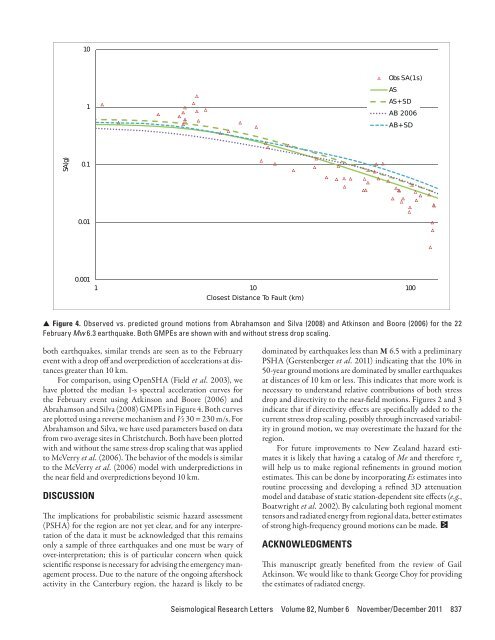Here - Stuff
Here - Stuff
Here - Stuff
Create successful ePaper yourself
Turn your PDF publications into a flip-book with our unique Google optimized e-Paper software.
10Obs SA(1s)AS1AS+SDAB 2006AB+SDSA(g)0.10.010.0011 10 100Closest Distance To Fault (km)▲ ▲ Figure 4. Observed vs. predicted ground motions from Abrahamson and Silva (2008) and Atkinson and Boore (2006) for the 22February Mw 6.3 earthquake. Both GMPEs are shown with and without stress drop scaling.both earthquakes, similar trends are seen as to the Februaryevent with a drop off and overprediction of accelerations at distancesgreater than 10 km.For comparison, using OpenSHA (Field et al. 2003), wehave plotted the median 1-s spectral acceleration curves forthe February event using Atkinson and Boore (2006) andAbrahamson and Silva (2008) GMPEs in Figure 4. Both curvesare plotted using a reverse mechanism and Vs 30 = 230 m/s. ForAbrahamson and Silva, we have used parameters based on datafrom two average sites in Christchurch. Both have been plottedwith and without the same stress drop scaling that was appliedto McVerry et al. (2006). The behavior of the models is similarto the McVerry et al. (2006) model with underpredictions inthe near field and overpredictions beyond 10 km.DISCUSSIONThe implications for probabilistic seismic hazard assessment(PSHA) for the region are not yet clear, and for any interpretationof the data it must be acknowledged that this remainsonly a sample of three earthquakes and one must be wary ofover-interpretation; this is of particular concern when quickscientific response is necessary for advising the emergency managementprocess. Due to the nature of the ongoing aftershockactivity in the Canterbury region, the hazard is likely to bedominated by earthquakes less than M 6.5 with a preliminaryPSHA (Gerstenberger et al. 2011) indicating that the 10% in50-year ground motions are dominated by smaller earthquakesat distances of 10 km or less. This indicates that more work isnecessary to understand relative contributions of both stressdrop and directivity to the near-field motions. Figures 2 and 3indicate that if directivity effects are specifically added to thecurrent stress drop scaling, possibly through increased variabilityin ground motion, we may overestimate the hazard for theregion.For future improvements to New Zealand hazard estimatesit is likely that having a catalog of Me and therefore τ awill help us to make regional refinements in ground motionestimates. This can be done by incorporating Es estimates intoroutine processing and developing a refined 3D attenuationmodel and database of static station-dependent site effects (e.g.,Boatwright et al. 2002). By calculating both regional momenttensors and radiated energy from regional data, better estimatesof strong high-frequency ground motions can be made.ACKNOWLEDGMENTSThis manuscript greatly benefited from the review of GailAtkinson. We would like to thank George Choy for providingthe estimates of radiated energy.Seismological Research Letters Volume 82, Number 6 November/December 2011 837
















